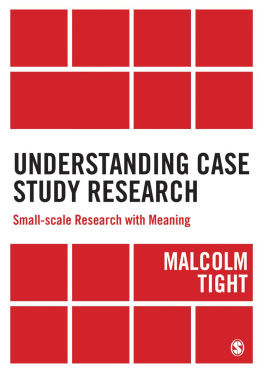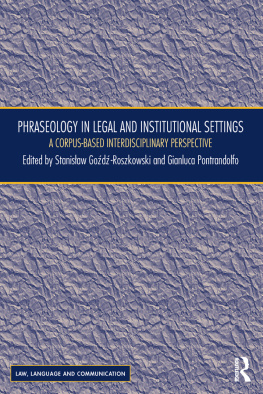Case Studies in
Interdisciplinary
Research
Case Studies in
Interdisciplinary
Research
Allen F. Repko
The University of Texas at Arlington
William H. Newell
Miami University of Ohio
Rick Szostak
University of Alberta
Copyright 2012 by SAGE Publications, Inc.
All rights reserved. No part of this book may be reproduced or utilized in any form or by any means, electronic or mechanical, including photocopying, recording, or by any information storage and retrieval system, without permission in writing from the publisher.
For information:
 | SAGE Publications, Inc.
2455 Teller Road
Thousand Oaks,
California 91320
E-mail:
| SAGE Publications India Pvt. Ltd.
B 1/I 1 Mohan Cooperative
Industrial Area
Mathura Road, New Delhi 110 044
India
|
SAGE Publications Ltd.
1 Olivers Yard
55 City Road
London EC1Y 1SP
United Kingdom | SAGE Publications
Asia-Pacific Pte. Ltd.
33 Pekin Street #02-01
Far East Square
Singapore 048763 |
Printed in the United States of America
Library of Congress Cataloging-in-Publication Data
Case studies in interdisciplinary research / Editors: Allen F. Repko, William H. Newell, Rick Szostak.
p. cm.
Includes bibliographical references and index.
ISBN 978-1-4129-8248-1 (pbk.)
1. Interdisciplinary researchCase studies. I. Repko, Allen F. II. Newell, William H. III. Szostak, Rick, 1959-
| Q180.55.I48C37 2012 |
| 001.4dc22 | 2010035403 |
This book is printed on acid-free paper.
11 12 13 14 15 10 9 8 7 6 5 4 3 2 1
| Acquisitions Editor: | Vicki Knight |
| Associate Editor: | Lauren Habib |
| Editorial Assistant: | Kalie Koscielak |
| Production Editor: | Catherine M. Chilton |
| Copy Editor: | Diana Breti |
| Typesetter: | C&M Digitals (P) Ltd. |
| Proofreader: | Eleni Georgiou |
| Indexer: | Molly Hall |
| Cover Designer: | Candice Harman |
| Permissions: | Adele Hutchinson |
Brief Contents
Allen F. Repko, Rick Szostak, William H. Newell
The Interdisciplinary Research Process
Rick Szostak |
Jewish Marriage as an Expression of Israels Conflicted Identity
Marilyn R. Tayler |
The Metropolitan Problem in Interdisciplinary Perspective
Michan Andrew Connor |
Mektoub: When Art Meets History, Philosophy, and Linguistics
Mieke Bal |
Integrating Theory-Based Insights on the Causes of Suicide Terrorism
Allen F. Repko |
An Interdisciplinary Analysis of the Causes of Economic Growth
Rick Szostak |
Why We Talk: An Interdisciplinary Approach to the Evolutionary Origin of Language
Ria van der Lecq |
Understanding Human Action: Integrating Meanings, Mechanisms, Causes, and Contexts
Machiel Keestra |
Integrative Theory in Criminology Applied to the Complex Social Problem of School Violence
Stuart Henry and Nicole L. Bracy |
Research Integration: A Comparative Knowledge Base
Julie Thompson Klein |
William H. Newell
Detailed Contents
Preface
Allen F. Repko, Rick Szostak, William H. Newell
Acknowledgments
1. The Interdisciplinary Research Process
Rick Szostak
2. Jewish Marriage as an Expression of Israels Conflicted Identity
Marilyn R. Tayler
3. The Metropolitan Problem in Interdisciplinary Perspective
Michan Andrew Connor
4. Mektoub: When Art Meets History, Philosophy, and Linguistics
Mieke Bal
5. Integrating Theory-Based Insights on the Causes of Suicide Terrorism
Allen F. Repko
6. An Interdisciplinary Analysis of the Causes of Economic Growth
Rick Szostak
7. Why We Talk: An Interdisciplinary Approach to the Evolutionary Origin of Language
Ria van der Lecq
8. Understanding Human Action: Integrating Meanings, Mechanisms, Causes, and Contexts
Machiel Keestra
9. Integrative Theory in Criminology Applied to the Complex Social Problem of School Violence
Stuart Henry and Nicole L. Bracy
10. Research Integration: A Comparative Knowledge Base
Julie Thompson Klein
Conclusion
William H. Newell
Preface
A s disciplines have generated increased understanding over the last century, it has become widely recognized that the complex problems facing humanity require new approaches for organizing, synthesizing, and applying this knowledge. Developing a comprehensive understanding of complex societal problems, and especially resolving them, requires interdisciplinary thinking and research.
The recent publication of several books on interdisciplinary research, including Julie Thompson Kleins (1990) Interdisciplinarity: History, Theory, and Practice and (2010) Creating Interdisciplinary Campus Cultures: A Model for Strength and Sustainability; William H. Newells (Ed.) (1998) Interdisciplinarity: Essays From the Literature; Peter Weingart and Nico Stehrs (Eds.) (2000) Practicing Interdisciplinarity; Carol S. Palmers (2001) Work at the Boundaries of Science; Rick Szostaks (2004) Classifying Science: Phenomena, Data, Theory, Method, Practice; The National Academies (2005) Facilitating Interdisciplinary Research; Tress et al.s (2005) From Landscape Research to Landscape Planning: Aspects of Integration, Education, and Application; Sharon J. Derry, Christian D. Schunn, and Morton Ann Gernsbachers (Eds.) (2005) Interdisciplinary Collaboration: An Emerging Cognitive Science; John Atkinson and Malcolm Crowes (Eds.) (2006) Interdisciplinary Research: Diverse Approaches in Science, Technology, Health, and Society; Allen Repkos (2008) Interdisciplinary Research: Process and Theory; and Rick Szostaks (2009) The Causes of Economic Growth: Interdisciplinary Perspectives, shows that the growing and diverse field of interdisciplinary studies has come of age. These works offer a variety of insights into interdisciplinary research, share a common conception of interdisciplinarity, and appreciate that integration is the best way to address complex problems.
In particular, Repkos (2008) book stresses the need for students and scholars alike to be self-consciously interdisciplinary and approach the research process in a way that is explicitly interdisciplinary. The book invites students and academics to think about, and hopefully practice, interdisciplinarity in a more systematic and methodologically self-conscious way. It also demonstrates how to use the disciplines in interdisciplinary work, critically evaluate disciplinary insights, create common ground among conflicting insights, perform integration, and produce a more comprehensive and nuancedunderstanding of a problem. Now that an integrated model of the interdisciplinary research process exists, it needs to be applied to a variety of complex problems in language that is comprehensible to students and non-specialists.











